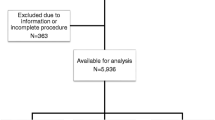Abstract
Objective(s)
To audit the practice and effectiveness of second generation endometrial ablation techniques (microwave and thermal balloon ablation).
Design and methods
An audit of microwave and balloon endometrial ablation procedures was completed and performed during a 2-year period, in two district hospitals of Calderdale and Huddersfield NHS Trust, UK. Patients were followed up with for a maximum of 1 year postoperatively, or were referred again from their GPs, with symptoms. A questionnaire was also completed to evaluate patient satisfaction.
Results
About 136 and 59 women underwent balloon and microwave endometrial ablation, respectively (Total = 195), for heavy periods. By the end of year 1, 16% of patients were amenorrhoeic and 60% had lighter periods. About 15% of women did not have any relief of symptoms and needed a hysterectomy by 3 years. There were no statistically significant differences in the endometrial ablation techniques. There was no significant effect of age, body mass index, utero-cervical length, or the ablation technique on the results or the hysterectomy rates. A satisfaction survey showed that 75% of women felt better after the procedure and would recommend it to a close friend.
Conclusions
Second generation ablation techniques are safe and effective methods of treating dysfunctional uterine bleeding, and are easy to use. They have reduced the incidence of hysterectomies and also have financial implications for healthcare providers.

Similar content being viewed by others
References
National Institute for health and Clinical Excellence (2007) Heavy menstrual bleeding—clinical guideline 44. NICE, London
Lethaby A, Hickey M, Garry R (2005) Endometrial destruction techniques for heavy menstrual bleeding. Cochrane Database Syst Rev 4:CD001501
Gynecare Thermachoice® Instructions for use Gynecare worldwide, Division of Ethicon inc., A Johnson and Johnson Company, New Brunswick
Jack SA, Cooper KG (2005) Microwave endometrial ablation: an overview. Rev Gynaecol Pract 5:32–38. doi:10.1016/j.rigp.2004.06.005
Vilos GA, Edris F (2007) Second generation endometrial ablation technologies: the hot liquid balloons. Best Pract Res Clin Obstet Gynaecol 21(6):947–967. doi:10.1016/j.bpobgyn.2007.03.022
Garside R, Stein K, Wyatt K, Round A, Price A (2004) The effectiveness and cost-effectiveness of microwave and thermal balloon endometrial ablation for heavy menstrual bleeding: a systematic review and economic modeling. Health Technol Assess 8(3):1–155
Sambrook AM, Parkin DE (2005) Endometrial ablation—a review of second generation techniques. Rev Gynaecol Pract 5:166–171. doi:10.1016/j.rigp.2005.03.001
McGurgan P, O’Donovan P (2007) Second generation endometrial ablation—an overview. Best Pract Res Clin Obstet Gynaecol 21(6):931–945. doi:10.1016/j.bpobgyn.2007.03.015
Hodgson DA, Feldberg IB, Sharp N, Cronin N, Evans M, Hirschowitz L (1999) Microwave endometrial ablation: development, clinical trials and outcomes at three years. Br J Obstet Gynaecol 106(7):684–694
Acknowledgments
Sincere thanks to Christine Ackroyd and all the staff of the Audit Department and the Department of Obstetrics and Gynaecology, Calderdale and Huddersfield NHS trust for their cooperation in completing this audit.
Conflict of interest statement
The authors declare no conflicts of interest.
Author information
Authors and Affiliations
Corresponding author
Rights and permissions
About this article
Cite this article
Madhu, C.K., Nattey, J. & Naeem, T. Second generation endometrial ablation techniques: an audit of clinical practice. Arch Gynecol Obstet 280, 599–602 (2009). https://doi.org/10.1007/s00404-009-0982-7
Received:
Accepted:
Published:
Issue Date:
DOI: https://doi.org/10.1007/s00404-009-0982-7



